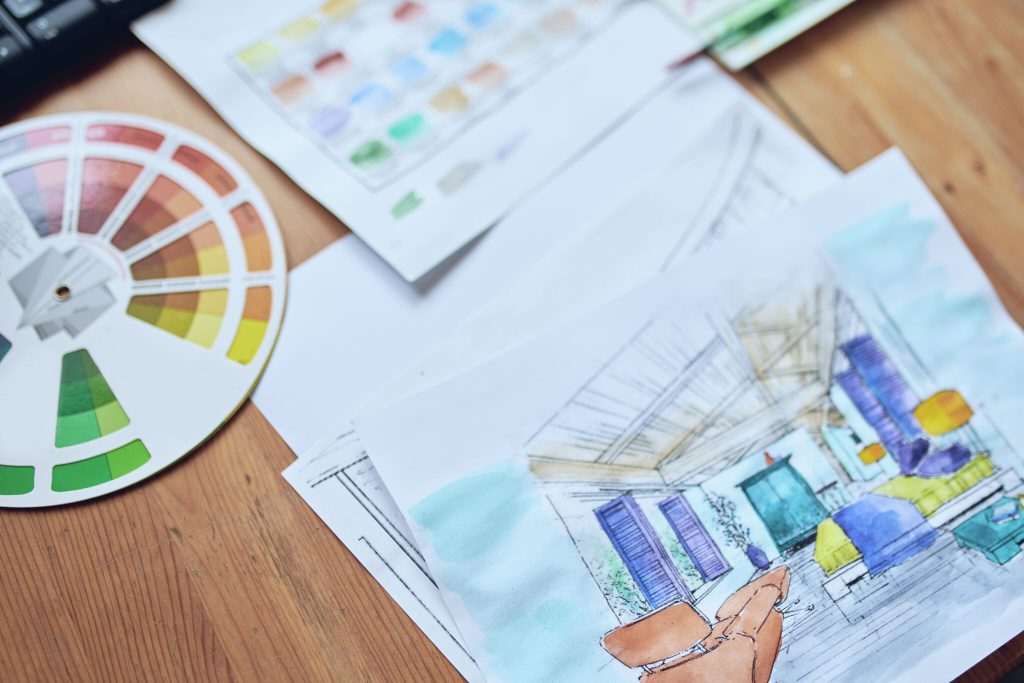Homeowners generally have two choices when their home no longer works for them: sell or renovate. Right now, however, staying and renovating might be a better option than buying a new home.
Ekaterina Goncharova/Getty Images
Even if you were lucky enough to land your dream home, it might not suit your needs forever. After all, a once-perfect home can become too small for a growing family, too big after the kids move out, or too crowded if you work from home. Likewise, preferences change over time, and features you once loved can feel outdated (or even annoying).
If your home no longer works for you — for whatever reason — you generally have two choices: sell or renovate. Right now, however, staying put and updating your digs might be a better option than buying a new home. Here’s why.
Current mortgage rates
High mortgage rates are one reason renovating might make more sense than buying.
Last October, mortgage rates reached a 20-year high as the Federal Reserve tamped down on inflation. As a result, at least in part, home sales have been plummeting. In January, they fell for the twelfth straight month, landing below April 2020 levels — that is, the height of early-pandemic lockdown. While mortgage rates have dipped slightly since their October peak (the Fed’s most recent rate hikes have been less dramatic), they’re still high.
Amid these high rates, homeowners are experiencing what the Urban Institute calls the “I hate my house, but I love my mortgage” syndrome. Essentially, homeowners who locked in bargain rates are likely to be in their homes longer than planned because they’re unwilling (or unable) to take on a more expensive mortgage. That can make staying put and sprucing up your home the more attractive option.
At the same time, high mortgage rates are forcing some sellers to lower their prices and accept concessions that were unheard of during the pandemic-inspired buying frenzy. Depending on what happens in your local real estate market, you might not get the price you’re hoping for if you sell — another reason to stay put.
Home equity loans are booming right now
Renovating is also a smart choice right now because homeowners are sitting on near-record levels of home equity following a decade-long housing market boom. People with mortgages saw their equity increase by $2.2 trillion between the third quarter of 2021 and the same period in 2022, according to real estate data service CoreLogic.
Homeowners can tap into that equity — via home equity loans and HELOCs — and use the cash for renovations (or anything else) while preserving the low rate on their existing mortgage. According to a TransUnion report, homeowners took out 322,537 home equity loans in the third quarter last year (the most recent data available) — a 47% increase from the same quarter in 2021. Banks also granted 405,646 home equity lines of credit (HELOCs) during the same period, up 41% from a year earlier. Bottom line: It can make financial sense to invest in improving what you already have.
Homes are getting older
Another reason renovating might be a good idea is that homes are getting older — and many need a little (or a lot of) TLC.
According to a report from the National Association of Home Builders (NAHB), nearly half of owner-occupied homes were built before 1980, and about 35% were constructed earlier than 1970. Meanwhile, just 10% of homes were built in 2010 or later. The aging housing stock signals a growing remodeling market, as older homes need repairs, new amenities, and updating. (For starters, open concept floor plans, which started popping up in the 1970s and became nearly pervasive in the ’90s, are out and clearly defined rooms are in.) Remodeling, NAHB says, may grow faster in the long run than new construction.
What is a home equity loan, and how does it work?
A home equity loan lets you access your home equity without selling or refinancing the house, using the house as collateral. Your lender gives you a set amount (an upfront lump sum) that you repay with interest over a fixed term. You can generally borrow up to 80% of the equity in your home, but the exact amount depends on your income, credit history, and the home’s market value.
Home equity loan vs. HELOC
Like a home equity loan, a HELOC lets you borrow using your home as collateral. But instead of receiving a lump sum from your lender, you have access to a revolving line of credit. Throughout the “draw” period — which generally lasts five to ten years — you can borrow up to your credit limit, repay it, and borrow again as often as you like. During that time, you generally pay only interest on the borrowed amount (which can make the payment easier to manage than a home equity loan’s fixed payment).
When the draw period ends, the HELOC closes, and you have a set amount of time (typically up to 20 years) to repay the amount you borrowed — plus interest, of course.
TIP: Cash-out refinancing also lets you tap into your home equity, but it replaces your current mortgage with a new, bigger loan (based on your existing balance plus the cash you withdraw). This type of loan is a poor option today: Most homeowners would end up with a higher mortgage rate.
Home equity loan rates
Like purchase mortgages, home equity interest rates vary by lender and loan type. HELOCs often have lower starting interest rates than home equity loans — but the rates are variable and can change over time. On the other hand, home equity loans have fixed interest rates, so the rate you lock in is the rate you pay for the entire loan term.
The pros and cons of renovating
According to HomeAdvisor, home renovations and remodels average $48,464, with most projects falling between $18,004 and $79,185. While that’s no small chunk of change, some updates pay for themselves (meaning they boost the property value at resale). For instance, the National Association of Realtors’ 2022 Remodeling Impact Report found that homeowners could recoup:
- 147% of hardwood floor refinishing costs
- 118% of new wood flooring costs
- 100% of insulation upgrade costs
Renovations are never an easy task, so it can be helpful to consider the pros and cons before making any decisions. Here’s a rundown.
- A renovation can increase your home’s value.
- Renovations are typically cheaper than buying a new home.
- You can make custom changes based on your likes and preferences.
- You can add space to account for a growing family or changing lifestyle.
- You can take advantage of money-saving energy credits (effectively reducing renovation costs).
- You can lose money on a renovation if it doesn’t add value to your home.
- You might have to live elsewhere during the renovation, and paying for professional movers can be a hidden cost.
- Renovations often go over budget — both timewise and dollarwise.
- You could overbuild for the neighborhood, which could lessen the home’s resale value (most buyers don’t want the one expensive home in a lower-priced neighborhood).
- You might change your mind halfway through the project, increasing costs if you switch gears — or leaving you unhappy if you don’t.
How to get a home equity loan
A home equity loan can be a smart way to fund a renovation — while keeping your bargain mortgage rate intact. Here’s the basic process for getting a home equity loan if you decide one is right for you:
- Check your credit. Review your credit report to find out where you stand — and fix any errors negatively affecting your score. Most lenders want to see a credit score of 620 or higher. You can request a free credit report at AnnualCreditReport.com every 12 months from each of the three major consumer reporting agencies.
- Calculate your home equity. It’s the difference between your home’s value and what you owe on your mortgage. Lenders generally require borrowers to have at least 15% to 20% equity (you might need an appraisal to confirm your home’s value).
- Consider your other debts. A little consumer debt is standard, but too much can scare lenders away. Lenders typically expect a debt-to-income (DTI) ratio of 43% or lower.
- Get loan estimates. A loan estimate provides details about the loan, including the estimated interest rate, monthly payment, and closing costs. Be sure to compare offers from several lenders to find the best rate and terms.
- Complete the lender’s application. Banks, credit unions, and non-bank lenders offer home equity loans. Depending on the lender, you can apply for the loan online, by phone, or in person. Once you’re approved and have cash in hand, you can get started on your renovation project.
The bottom line
After falling from their October highs, mortgage rates have begun creeping up again in response to the Federal Reserve’s continued efforts to rein in inflation. The Fed has indicated it’s likely to continue raising the interest rate on federal funds at least a few more times in 2023. If that’s the case, mortgage rates will likely continue to rise as well. A home equity loan can help you invest in your satisfaction now and make your home even more valuable when you’re finally ready to move on.
HELOC and Home Equity Loan FAQs
What are good home equity loan rates?
The best home equity loan rates can vary by lender. The average national rate for a home equity loan in August 2023 was between 7.97% and 9.84%. To find the most competitive rates, it’s best to do your research and shop around for the right lender for your needs.
What are the best HELOC rates?
As of August 2023, the average national rate for a home equity line of credit (HELOC) is between 7.70% and 9.71%. To get the best HELOC rates you will need to have a good credit score, a low debt-to-income ratio, a high enough income, and a reliable payment history. Even if all of these factors apply to you, it’s important to get quotes from at least a few lenders.
A HELOC is a revolving line of credit, which makes it similar to using a credit card. HELOCs usually come with a draw period of 10 years, followed by a repayment period. During the draw period, you can access funds as needed and repay only the interest as you go. Each time you make a payment, your credit line will replenish. During the repayment period, you’ll make larger payments that include both principal and interest. HELOCs tend to come with variable interest rates, but some lenders offer fixed payment options. A HELOC is a great option if you’re not sure how much you’ll need to borrow.
What is a fixed-rate HELOC?
A fixed-rate HELOC is considered a hybrid product because it combines a home equity loan’s fixed interest rate with a HELOC’s credit line. You can withdraw money (up to your credit limit) just like you would with a traditional HELOC. But unlike a variable HELOC, you lock in all or a portion of your balance at a fixed interest rate during the draw period. This can make it easier to plan and budget while protecting you from future interest rate hikes.
What is the best HELOC strategy?
Just because you can use a HELOC for anything doesn’t mean you should. After all, your house is on the line, and you risk losing it to foreclosure if you default on the payments. For this reason, the best HELOC strategy is to use the HELOC to boost your home’s value or strengthen your financial situation in some other way.
Is HELOC interest tax deductible?
The interest you pay on a HELOC can be tax-deductible — but not always. It all depends on what you use the funds for. According to the IRS, you can only deduct the interest you pay on a home equity loan or line of credit if “the borrowed funds are used to buy, build, or substantially improve the taxpayer’s home that secures the loan.” Here’s a closer look at the nuances involved in the question of whether heloc interest is tax-deductible.
How can I increase my home’s value?
If you’re researching home equity loans and HELOCs, you’ve probably started wondering how you can increase your home’s value. Check out our guide for tips, including investing in smart energy, replacing your roof, and refinishing hardwood floors.
What is a home improvement loan?
A home improvement loan is an unsecured loan that you can use to pay for various home repairs and renovations — such as a roof replacement, furnace/HVAC repairs, kitchen or bathroom remodel, deck addition, solar panel installation or landscaping. Loan amounts range from $3,000 to $100,000, which you repay with interest in monthly installments over one to five years.
Once you’re approved for a home equity loan, your lender gives you the funds as an upfront lump sum. This makes home equity loans ideal for homeowners who want to borrow a specific amount for a major project or big one-time expense. To repay the loan, you make fixed monthly payments (with interest, of course) over a set term ranging from five to 30 years.
TIP: Remember that home equity loan payments are in addition to your usual mortgage payments, so budget accordingly. If you default on the loan payments, your lender can foreclose on your home.
How can I get a home equity loan?
- Calculate how much equity you have in your home.
- Decide how much you need to borrow.
- Compare borrowing limits, features, terms, and customer reviews across lenders.
- Get quotes from a handful of lenders that meet your needs.
- Choose the lender with the lowest rate offer and submit a formal application, which will require a hard credit check.
- Schedule an appraisal.
- Wait for approval and close on your loan.
- Begin repayment.
More HELOC & Home Equity Tips
Editorial Disclosure: All articles are prepared by editorial staff and contributors. Opinions expressed therein are solely those of the editorial team and have not been reviewed or approved by any advertiser. The information, including rates and fees, presented in this article is accurate as of the date of the publish. Check the lender’s website for the most current information.
This article was originally published on SFGate.com and reviewed by Lauren Williamson, who serves as Financial and Home Services Editor for the Hearst E-Commerce team. Email her at [email protected].
Read the full article here














